Berg J.M., Tymoczko J.L., Stryer L. Biochemistry
Подождите немного. Документ загружается.

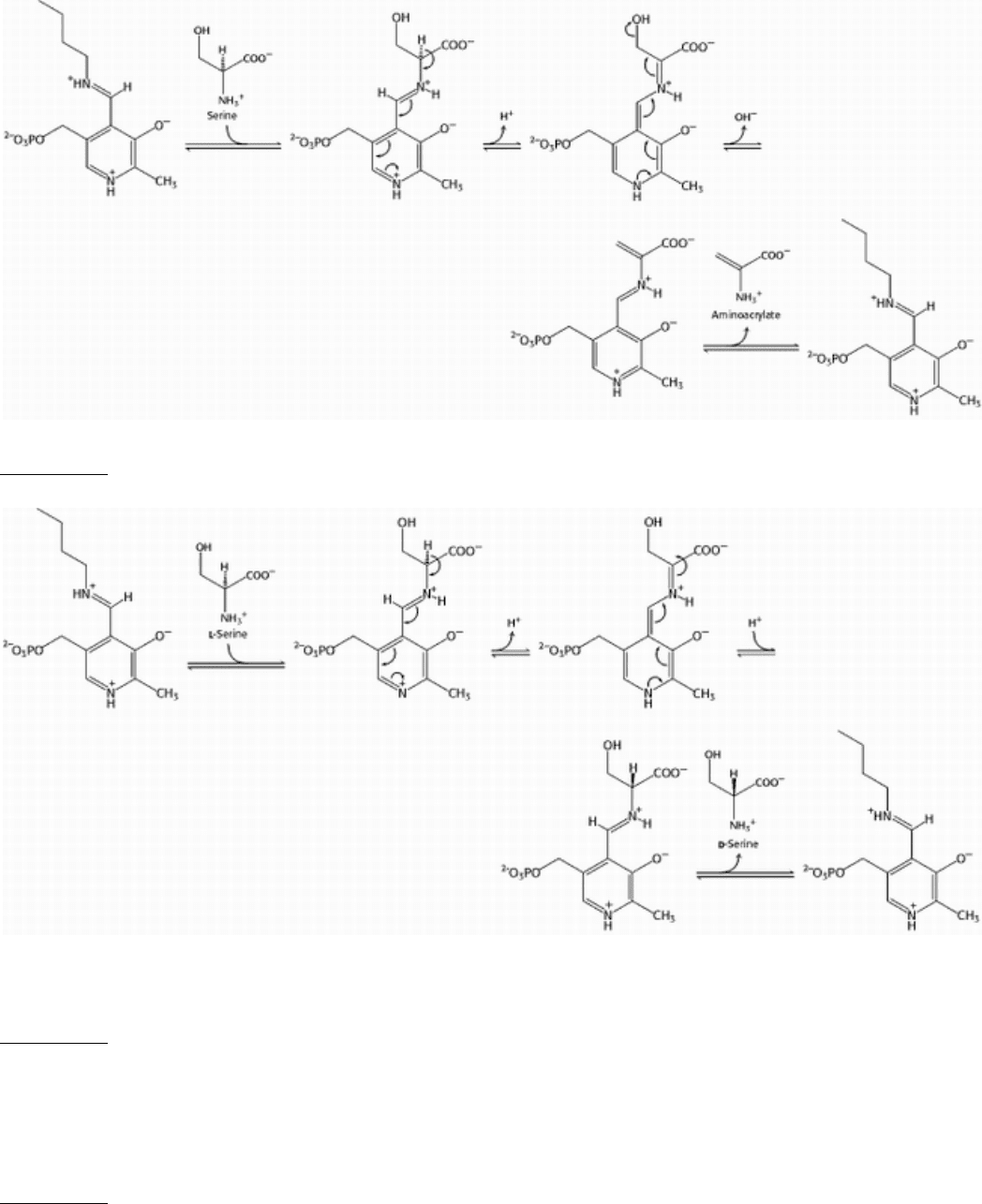
See question
16.
The equilibrium constant for the interconversion of
l-serine and d-serine is exactly 1.
See question
17.
Exposure of such a domain would suggest that a component of a multiprotein complex has failed to form properly,
or that one component has been synthesized in excess. This will lead to rapid degradation and restoration of
appropriate stoichiometries.
See question
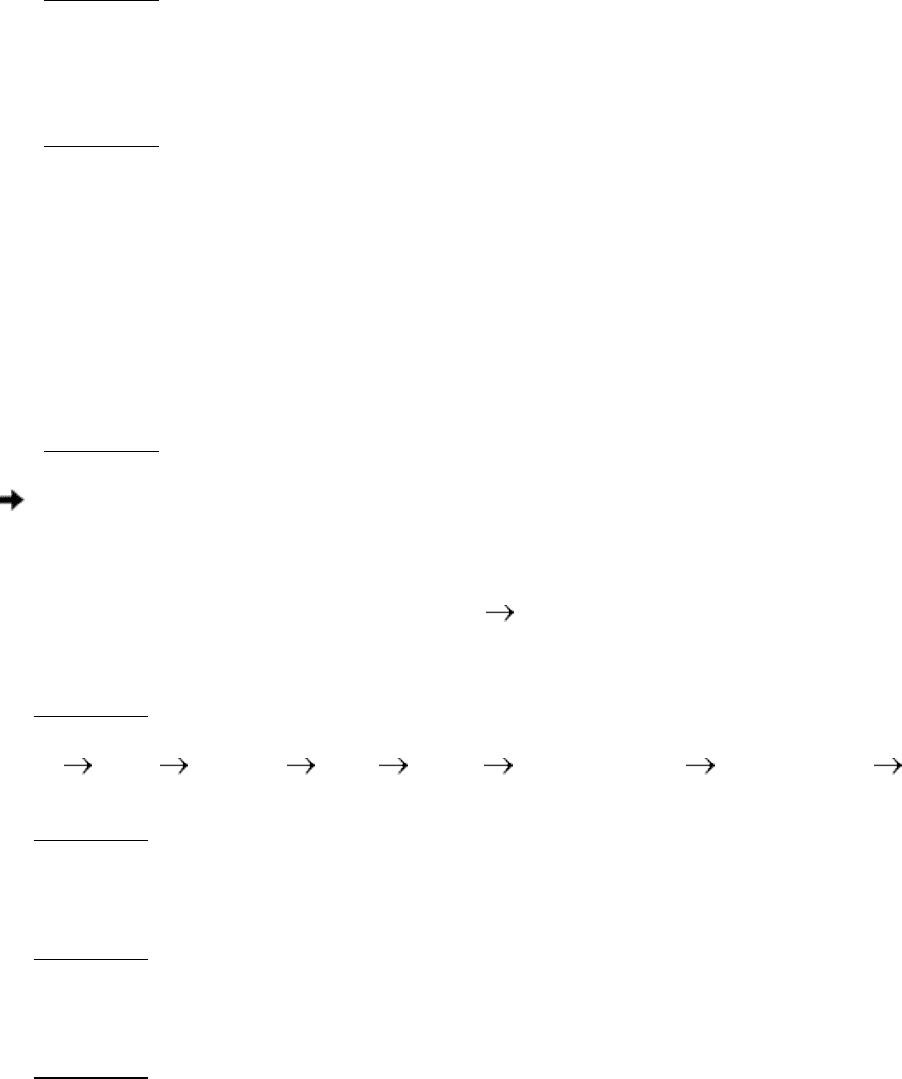
18.
(a) Depletion of glycogen stores. When they are gone, proteins must be degraded to meet the glucose needs of the
brain. The resulting amino acids are deaminated, and the nitrogen atoms are excreted as urea.
(b) The brain has adapted to the use of ketone bodies, which are derived from fatty acid catabolism. In other words,
the brain is being powered by fatty acid breakdown.
(c) When the glycogen and lipid stores are gone, the only available energy source is protein.
See question
19.
Deamination to α-keto-β-methylvalerate; oxidative decarboxylation to α-methylbutyryl CoA; oxidation to tiglyl
CoA; hydration, oxidation and thiolysis yields acetyl CoA and propionyl CoA; propionyl CoA to succinyl CoA.
See question
20.
(a) Virtually no digestion in the absence of nucleotides. (b) Protein digestion is greatly stimulated by the presence
of ATP. (c) AMP-PNP, a nonhydrolyzable analog of ATP, is no more effective than ADP. (d) The proteasome
requires neither ATP nor PAN to digest small substrates. (e) PAN and ATP hydrolysis may be required to unfold
the peptide and translocate it into the proteasome. (f) Although Thermoplasma PAN is not as effective with the
other proteasomes, it nonetheless results in threefold to fourfold stimulation of digestion. (g) In light of the fact that
the archaea and eukarya diverged several billion years ago, the fact that Thermoplasma PAN can stimulate rabbit
muscle suggests homology not only between the proteasomes, but also between PAN and the 19S subunit (most
likely the ATPases) of the mammalian 26S proteasome.
See question
Answers to Problems
Chapter 24
1.
Glucose + 2 ADP + 2 P
i
+ 2 NAD
+
+ 2 glutamate 2 alanine + 2 α-ketoglutarate + 2 ATP + 2 NADH + 2 H
2
O + 2
H
+
See question
2.
N
2
NH
4
+
glutamate serine glycine δ-aminolevulinate porphobilinogen heme
See question
3.
(a) N
5
, N
10
-Methylenetetrahydrofolate; (b) N
5
-methyltetra-hydrofolate.
See question
4.
γ-Glutamyl phosphate is a likely reaction intermediate.
See question
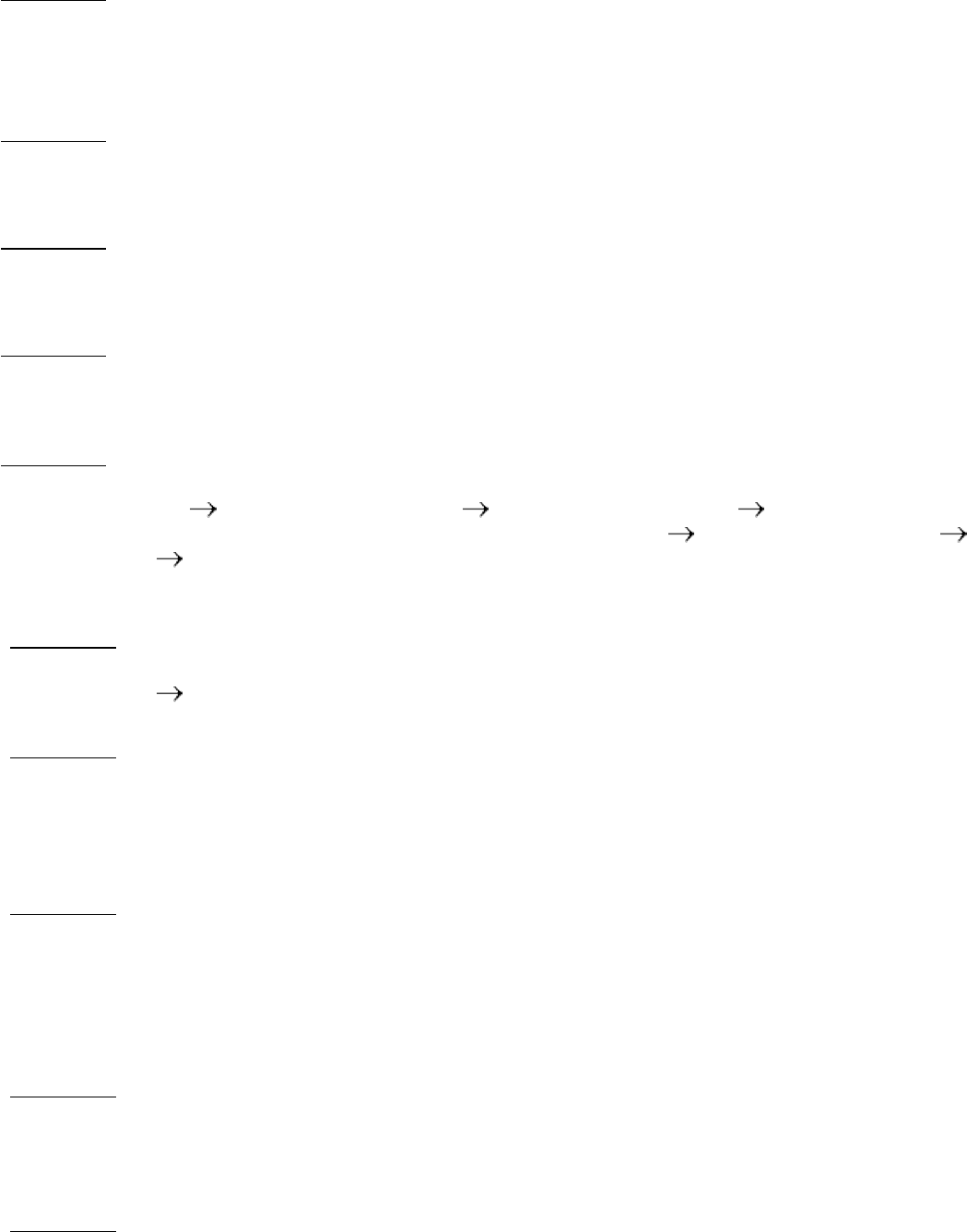
5.
The administration of glycine leads to the formation of isovalerylglycine. This water-soluble conjugate, in contrast
with isovaleric acid, is excreted very rapidly by the kidneys.
See question
6.
They carry out nitrogen fixation. The absence of photosystem II provides an environment in which O
2
is not
produced. Recall that the nitrogenase is very rapidly inactivated by O
2
.
See question
7.
The cytosol is a reducing environment, whereas the extracellular milieu is an oxidizing environment.
See question
8.
Succinyl CoA is formed in the mitochondrial matrix.
See question
9.
Alanine from pyruvate; aspartate from oxaloacetate; glutamate from α-ketoglutarate.
See question
10.
Y could inhibit the C
D step, Z could inhibit the C F step, and C could inhibit A B. This scheme is an
example of sequential feedback inhibition. Alternatively, Y could inhibit the C D step, Z could inhibit the C
F step, and the A B step would be inhibited only in the presence of both Y and Z. This scheme is called
concerted feedback inhibition.
See question
11.
The rate of the A
B step in the presence of high levels of Y and Z would be 24 s
-1
(0.6 × 0.4 × 100 s
-1
).
See question
12.
An external aldimine forms with SAM, which is deprotonated to form the quinonoid intermediate. The
deprotonated carbon atom attacks the carbon atom adjacent to the sulfur atom to form the cyclopropane ring and
release methyl thio-adenosine, the other product.
See question
13.
An external aldimine forms with l-serine, which is deprotonated to form the quinonoid intermediate. This
intermediate is reprotonated on its opposite face to form an aldimine with d-serine. This compound is cleaved to
release d-serine. The equilibrium constant for a racemization reaction is 1 because the reactant and product are
exact mirror images of each other.
See question
14.
Synthesis from oxaloacetate and α-ketoglutarate would deplete the citric acid cycle, which would decrease ATP
production. Anapleurotic reactions would be required to replenish the citric acid cycle.
See question
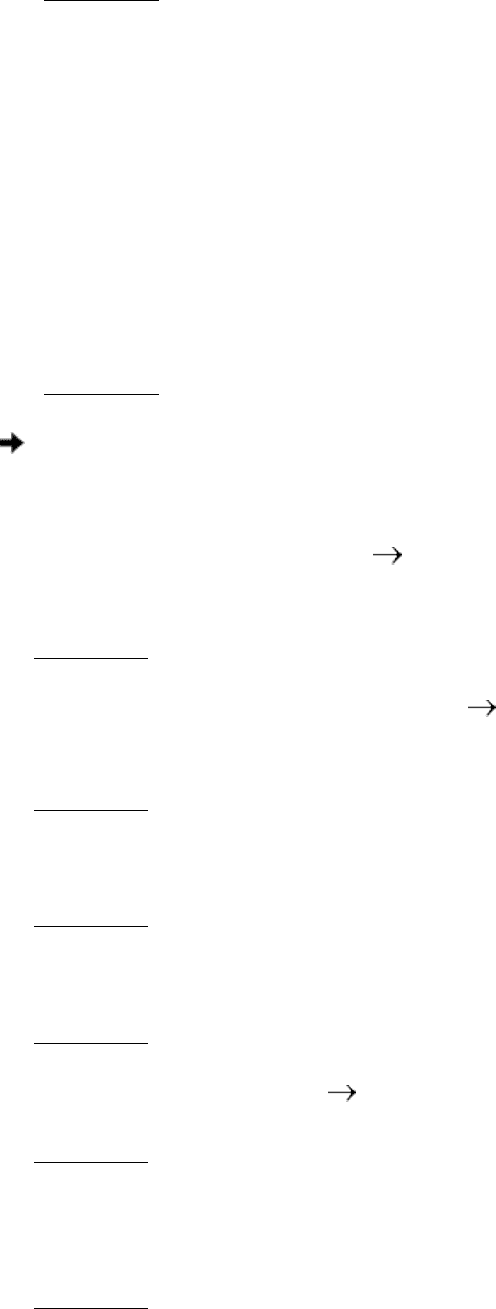
15.
SAM is the donor for DNA methylation reactions that protect a host from digestion by its own restriction enzymes.
A lack of SAM would render the bacterial DNA susceptible to digestion by the cell's own restriction enzymes.
See question
16.
(a) Asparagine is much more abundant in the dark. More glutamine is present in the light. These amino acids show
the most dramatic effects. Glycine also is more abundant in the light.
(b) Glutamine is a more metabolically reactive amino acid, used in the synthesis of many other compounds.
Consequently, when energy is available as light, glutamine will be preferentially synthesized. Asparagine, which
carries more nitrogen per carbon atom and is thus a more efficient means of storing nitrogen when energy is short,
is synthesized in the dark. Glycine is more prevalent in the light because of photorespiration.
(c) White asparagus has an especially high concentration of asparagine, which accounts for its intense taste. All
asparagus has a large amount of asparagine. In fact, as suggested by its name, asparagine was first isolated from
asparagus.
See question
Answers to Problems
Chapter 25
1.
Glucose + 2 ATP + 2 NADP
+
+ H
2
O PRPP + CO
2
+ ADP + AMP + 2 NADPH + 3 H
+
See question
2.
Glutamine + aspartate + CO
2
+ 2 ATP + NAD
+
orotate + 2 ADP + 2 P
i
+ glutamate + NADH + H
+
See question
3.
(a, c, d, and e) PRPP; (b) carbamoyl phosphate.
See question
4.
PRPP and formylglycinamide ribonucleotide.
See question
5.
dUMP + serine + NADPH + H
+
dTMP + NADP
+
+ glycine
See question
6.
There is a deficiency of N
10
-formyltetrahydrofolate. Sulfanilamide inhibits the synthesis of folate by acting as an
analog of p-aminobenzoate, one of the precursors of folate.
See question

7.
PRPP is the activated intermediate in the synthesis of phosphoribosylamine in the de novo pathway of purine
formation; of purine nucleotides from free bases by the salvage pathway; of orotidylate in the formation of
pyrimidines; of nicotinate ribonucleotide; of phosphoribosyl ATP in the pathway leading to histidine; and of
phosphoribosylanthranilate in the pathway leading to tryptophan.
See question
8.
(a) Cell A cannot grow in a HAT medium, because it cannot synthesize TMP either from thymidine or from dUMP.
Cell B cannot grow in this medium, because it cannot synthesize purines by either the de novo pathway or the
salvage pathway. Cell C can grow in a HAT medium because it contains active thymidine kinase from cell B
(enabling it to phosphorylate thymidine to TMP) and hypoxanthine-guanine phosphoribosyl transferase from cell A
(enabling it to synthesize purines from hypoxanthine by the salvage pathway).
(b) Transform cell A with a plasmid containing foreign genes of interest and a functional thymidine kinase gene. The
only cells that will grow in a HAT medium are those that have acquired a thymidylate kinase gene; nearly all of
these transformed cells will also contain the other genes on the plasmid.
See question
9.
These patients have a high level of urate because of the breakdown of nucleic acids. Allopurinol prevents the
formation of kidney stones and blocks other deleterious consequences of hyperuricemia by preventing the formation
of urate (Section 25.6.1).
See question
10.
The free energies of binding are -13.8 (wild type), -11.9 (Asn 27), and -9.1 (Ser 27) kcal mol
-1
(-57.7, -49.8, and -
38.1 kJ mol
-1
, respectively). The loss in binding energy is 1.9 kcal mol
-1
(7.9 kJ mol
-1
) and 4.7 kcal mol
-1
(19.7 kJ
mol
-1
).
See question
11.
Inosine or hypoxanthine could be administered.
See question
12.
N-1 in both cases, and the amine group linked to C-6 in ATP.
See question
13.
An oxygen atom is added to allopurinol to form alloxanthine.
See question
14.
The first reaction proceeds by phosphorylation of glycine to form an acyl phosphate followed by nucleophilic
attack by the amine of phosphoribosylamine to displace orthophosphate. The second reaction consists of
adenylation of the carbonyl group of xanthylate followed by nucleophilic attack by ammonia to displace AMP.
See question
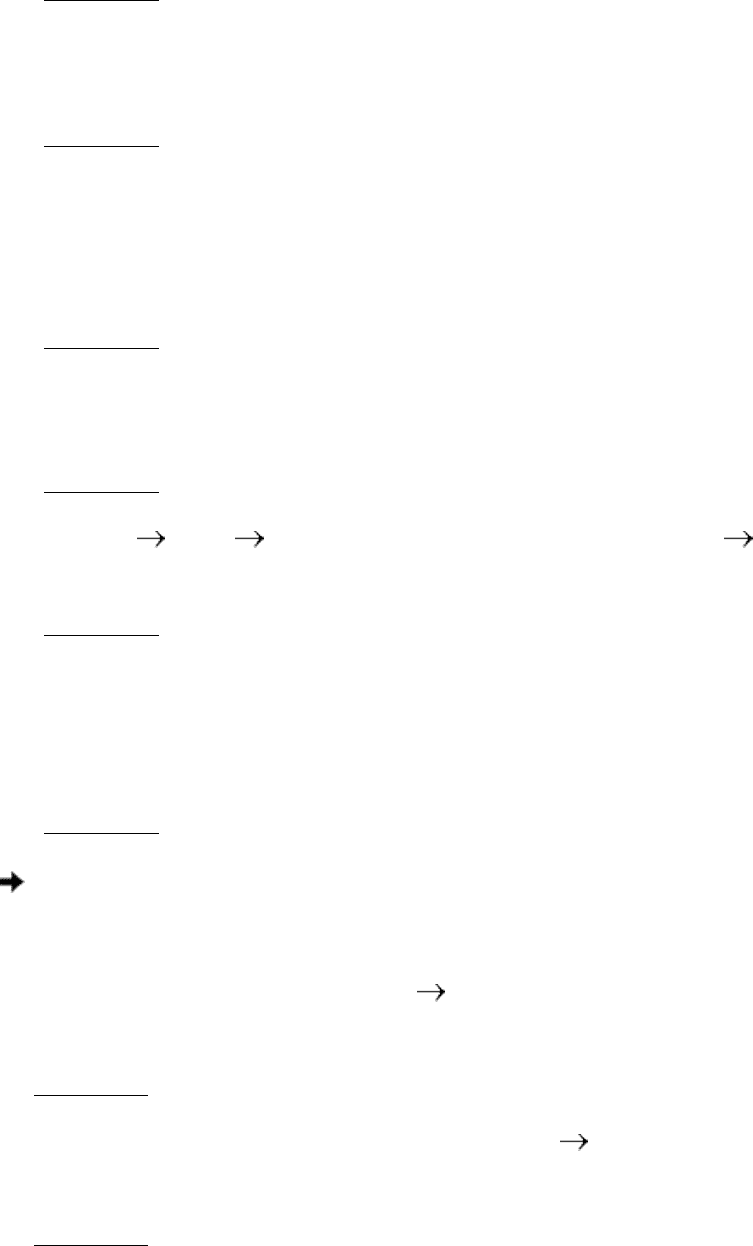
15.
The -NH
2
group attacks the carbonyl carbon atom to form a tetrahedral intermediate. Removal of a proton leads to
the elimination of water to form inosinate.
See question
16.
(a) cAMP; (b) ATP; (c) UDP-glucose; (d) acetyl CoA; (e) NAD
+
, FAD; (f) dideoxynucleotides; (g) fluorouracil;
(h) CTP inhibits ATCase.
See question
17.
In vitamin B
12
deficiency, methyltetrahydrofolate cannot donate its methyl group to homocysteine to regenerate
methionine. Because the synthesis of methyltetrahydrofolate is irreversible, the cell's tetrahydrofolate will
ultimately be converted into this form. No formyl or methylene tetrahydrofolate will be left for nucleotide
synthesis. Pernicious anemia illustrates the intimate connection between amino acid and nucleotide metabolism.
See question
18.
The cytosolic level of ATP in the liver falls and that of AMP rises above normal in all three conditions. The excess
AMP is degraded to urate.
See question
19.
Succinate malate oxaloacetate by the citric acid cycle. Oxaloacetate aspartate by transamination,
followed by pyrimidine synthesis. Carbons 4, 5, and 6.
See question
20.
(a) Some ATP can be salvaged from the ADP that is being generated. (b) There are equal numbers of high
phosphoryl transfer potential groups on each side of the equation. (c) Because the adenylate kinase reaction is at
equilibrium, removing AMP would lead to the formation of more ATP. (d) Essentially, the cycle serves as an
anapleurotic reaction for the generation of the citric acid cycle intermediate fumarate.
See question
Answers to Problems
Chapter 26
1.
Glycerol + 4 ATP + 3 fatty acids + 4 H
2
O triacyl-glycerol + ADP + 3 AMP + 7 P
i
+ 4 H
+
See question
2.
Glycerol + 3 ATP + 2 fatty acids + 2 H
2
O + CTP + serine phosphatidyl serine + CMP + ADP + 2 AMP + 6 P
i
+
3 H
+
See question

3.
(a) CDP-diacylglycerol; (b) CDP-ethanolamine; (c) acyl CoA; (d) CDP-choline; (e) UDP-glucose or UDP-galactose;
(f) UDP-galactose; (g) geranyl pyrophosphate.
See question
4.
(a and b) None, because the label is lost as CO
2
.
See question
5.
The categories of mutations are: (1) no receptor is synthesized; (2) receptors are synthesized but do not reach the
plasma membrane, because they lack signals for intracellular transport or do not fold properly; (3) receptors reach
the cell surface, but they fail to bind LDL normally because of a defect in the LDL-binding domain; (4) receptors
reach the cell surface and bind LDL, but they fail to cluster in coated pits because of a defect in their carboxyl-
terminal regions.
See question
6.
Deamination of cytidine to uridine changes CAA (Gln) into UAA (stop).
See question
7.
Benign prostatic hypertrophy can be treated by inhibiting 5α-reductase. Finasteride, the 4-aza steroid analog of
dihydrotestosterone, competitively inhibits the reductase but does not act on androgen receptors. Patients taking
finasteride have a markedly lower plasma level of dihydrotestosterone and a nearly normal level of testosterone. The
prostate gland becomes smaller, whereas testosterone-dependent processes such as fertility, libido, and muscle
strength appear to be unaffected.
See question
8.
Patients who are most sensitive to debrisoquine have a deficiency of a liver P450 enzyme encoded by a member of
the CYP2 subfamily. This characteristic is inherited as an autosomal recessive trait. The capacity to degrade other
drugs may be impaired in people who hydroxylate debrisoquine at a slow rate, because a single P450 enzyme
usually handles a broad range of substrates.
See question
9.
Many hydrophobic odorants are deactivated by hydroxylation. Molecular oxygen is activated by a cytochrome P450
monooxygenase. NADPH serves as the reductant. One oxygen atom of O
2
goes into the odorant substrate, whereas
the other is reduced to water.
See question
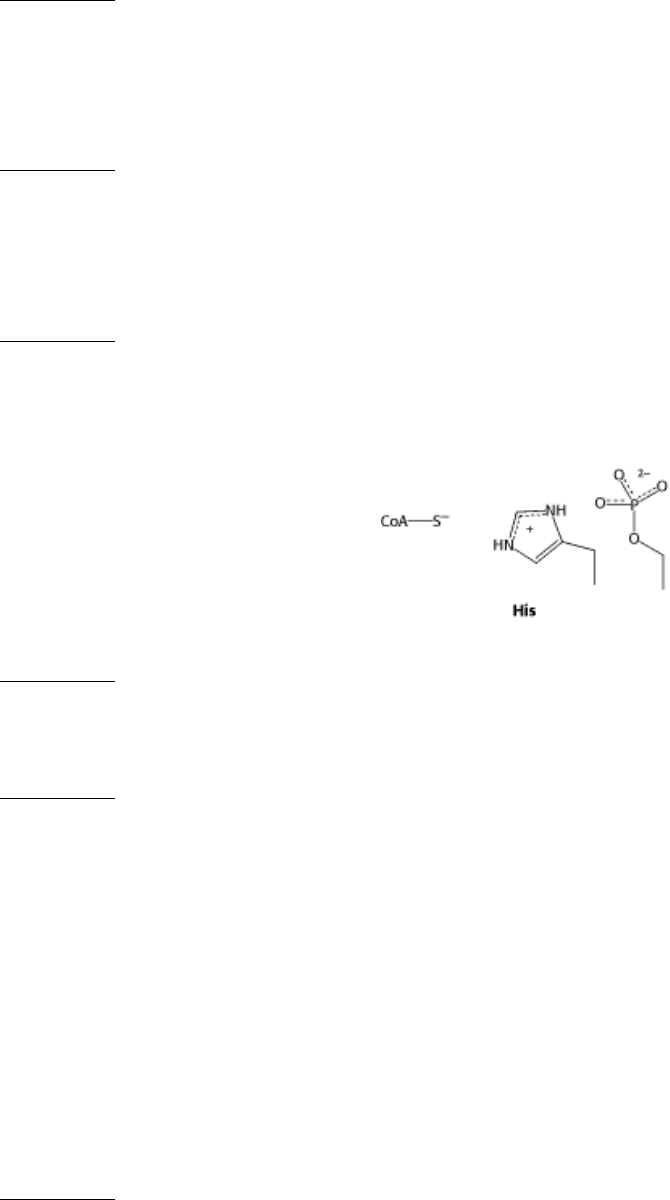
10.
Recall that dihydrotestosterone is crucial for the development of male characteristics in the embryo. If a pregnant
woman were to be exposed to Propecia, the 5α-reductase of the male embryo would be inhibited, which could
result in severe developmental abnormalities.
See question
11.
The oxygenation reactions catalyzed by the cytochrome P450 family permit greater flexibility in biosynthesis.
Because plants are not mobile, they must rely on physical defenses, such as thorns, and chemical defenses, such as
toxic alkaloids. The larger P450 array might permit greater biosynthetic versatility.
See question
12.
This knowledge would enable clinicians to characterize the likelihood of a patient's having an adverse drug reaction
or being susceptible to chemical-induced illnesses. It would also permit a personalized and especially effective
drug-treatment regime for diseases such as cancer.
See question
13.
The negatively charged phosphoserine residue interacts with the positively charged protonated histidine residue and
decreases its ability to transfer a proton to the thiolate.
See question
14.
The methyl group is first hydroxylated. The hydroxy-methylamine eliminated formaldehyde to form methylamine.
See question
15.
(a) There is no effect.
(b) Because actin is not controlled by cholesterol, the amount isolated should be the same in both experimental
groups. A difference would suggest a problem in the RNA isolation.
(c) The presence of cholesterol in the diet dramatically reduces the amount of HMG-CoA reductase protein.
(d) A common means of regulating the amount of a protein present is to regulate transcription, which is clearly not
the case here.
(e) Translation of mRNA could be inhibited. The protein could be rapidly degraded.
See question

Answers to Problems
Chapter 27
1.
DNA polymerase I uses deoxyribonucleoside triphosphates; pyrophosphate is the leaving group. DNA ligase uses a
DNA-adenylate (AMP joined to the 5
-phosphate) as a reaction partner; AMP is the leaving group. Topoisomerase I
uses a DNA-tyrosyl intermediate (5
-phosphate linked to the phenolic OH group); the tyrosine residue of the enzyme
is the leaving group.
See question
2.
FAD, CoA, and NADP
+
are plausible alternatives.
See question
3.
Positive supercoiling resists the unwinding of DNA. The melting temperature of DNA increases in proceeding from
negatively supercoiled to relaxed to positively supercoiled DNA. Positive supercoiling is probably an adaptation to
high temperature.
See question
4.
(a) There are long stretches of each because the transition is highly cooperative. (b) B-Z junctions are energetically
highly unfavorable. (c) A-B transitions are less cooperative than B-Z transitions because the helix stays right-handed
at an A-B junction but not at a B-Z junction.
See question
5.
(a) 96.2 revolutions per second (1000 nucleotides per second divided by 10.4 nucleotides per turn for B-DNA gives
96.2 rps).
(b) 0.34 µm/s (1000 nucleotides per second corresponds to 3400 Å/s because the axial distance between nucleotides
in B-DNA is 3.4 Å).
See question
6.
Eventually, the DNA would become so tightly wound that movement of the replication complex would be
energetically impossible.
See question
7.
A hallmark of most cancer cells is prolific cell division, which requires DNA replication. If the telomerase were not
activated, the chromosomes would shorten until they became nonfunctional, leading to cell death. Interestingly,
telomerase is often, but not always, found to be activated in cancer cells.
See question
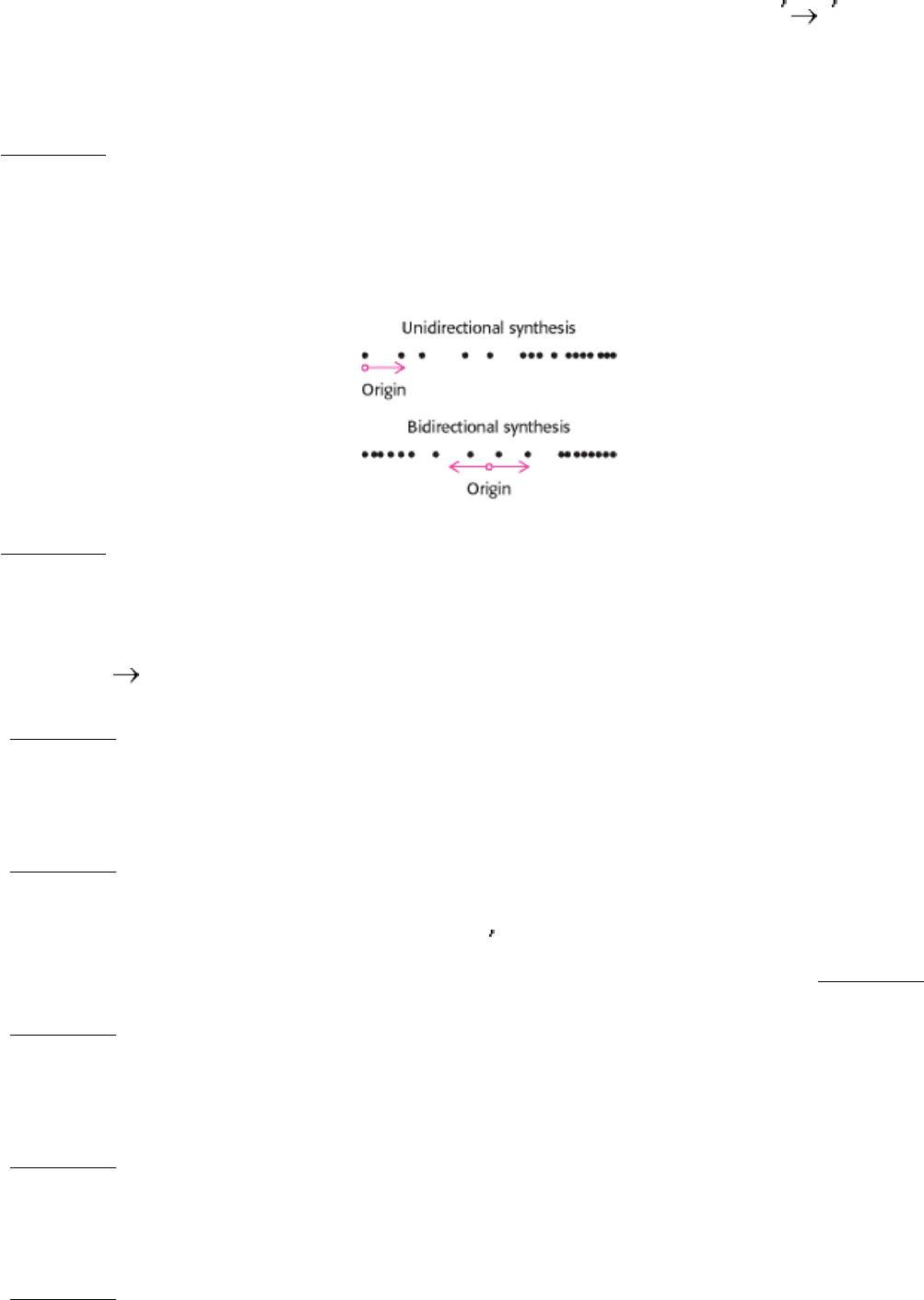
8.
Treat the DNA briefly with endonuclease to occasionally nick each strand. Add the polymerase with the radioactive
dNTPs. At the broken bond, or nick, the polymerase will degrade the existing strand with its 5
3 exonuclease
activity and replace it with a radioactive complementary copy by using its polymerase activity. This reaction scheme
is referred to as nick translation, because the nick is moved, or translated, along the DNA molecule without ever
becoming sealed.
See question
9.
If replication were unidirectional, tracks with a low grain density at one end and a high grain density at the other end
would be seen. On the other hand, if replication were bidirectional, the middle of a track would have a low density,
as shown in the adjoining diagram. For E. coli, the grain tracks are denser on both ends than in the middle, indicating
that replication is bidirectional.
See question
10.
(a) Pro (CCC), Ser (UCC), Leu (CUC), and Phe (UUC). Alternatively, the last base of each of these codons could
be U.
(b) These C
U mutations were produced by nitrous acid.
See question
11.
Potentially deleterious side reactions are prevented. The enzyme itself might be damaged by light if it could be
activated by light in the absence of bound DNA harboring a pyrimidine dimer.
See question
12.
DNA ligase relaxes supercoiled DNA by catalyzing the cleavage of a phosphodiester bond in a DNA strand. The
attacking group is AMP, which becomes attached to the 5
-phos- phoryl group at the site of scission. AMP is
required because this reaction is the reverse of the final step in the joining of pieces of DNA (see Figure 27.28).
See question
13.
ATP hydrolysis is required to release DNA topoisomerase II after the enzyme has acted on its DNA substrate.
Negative supercoiling requires only the binding of ATP, not its hydrolysis.
See question
14.
(a) Size; the top is relaxed and the bottom is supercoiled DNA. (b) Topoisomers. (c) The DNA is becoming
progressively more unwound, or relaxed, and thus slower moving.
See question
